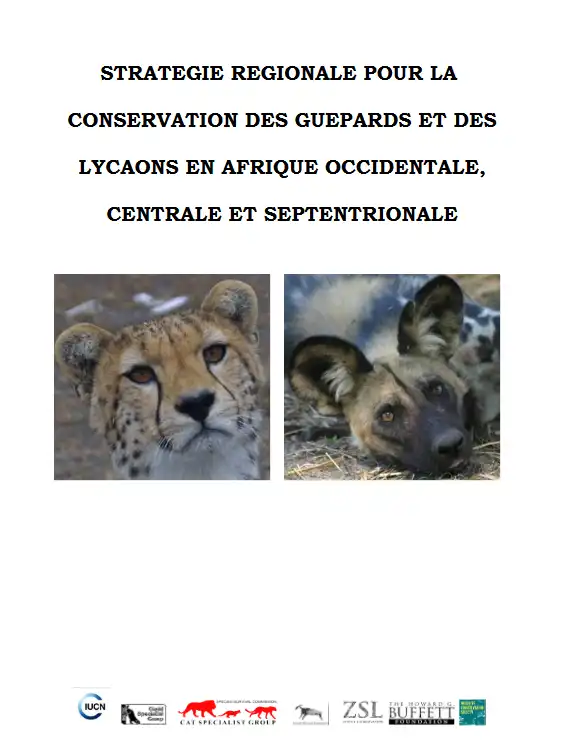Document
Document
REGIONAL STRATEGY FOR THE CONSERVATION OF CHEETAHS AND WILD DOGS IN WESTERN, CENTRAL AND NORTHERN AFRICA
The dog (Lycaon pictus) and the cheetah (Acinonyx jubatus) present major challenges for 21st century conversationists. Although all large carnivores require large spaces, wild dogs and cheetahs need the largest
ones to live. When the human population invades the last wild lands in Africa, these two endangered species are often the first to disappear. Western, Central, and Northern Africa contains populations of cheetahs and wild dogs that are of global ecological importance. This regional strategy is part of a program that aims to develop an action plan for the conservation of these species at the national level, in collaboration with wildlife authorities in this region of Africa, and the IUCN/CSE feline and canine specialist groups. Because of the similarity of the ecological
needs of wild dogs and cheetahs, it seems logical to plan their conservation together. In addition, the actions put in place for these two species will also benefit other carnivores such as lions, leopards and hyenas. The converse would not necessarily be true due to the unique need of cheetahs and wild dogs for a very large wild home range. This report describes the results of the regional workshop held in Niger in 2012, which aimed to plan the conservation of cheetahs and wild dogs in western, central and northern Africa.
The participants in this workshop represent the key stakeholders for cheetahs and wild dogs in the region. The list of participants includes members of wildlife authorities, non-governmental organizations (NGOs), as well as biologists specializing in these two species. In western, central and northern Africa, the geographical range of cheetahs and wild dogs has undergone an extreme reduction. The “resident”
populations now cover only 9% (cheetahs) and 4% (wild dogs) of their historical distribution in the region and these two species are considered to be irretrievably lost from 57% (cheetahs) and 69% (wild dogs) from this region.
Although protected areas are very important for the conservation of cheetahs and wild dogs, the majority of the range of these species is found outside of them. In western, central, and northern Africa, more than three-quarters of the range of cheetahs, and almost two-thirds of the range of wild dogs, is found without protection status. Few populations within protected areas would be viable if they were not connected to habitat outside of these areas. As a result, conservation actions outside protected areas are crucial for the long-term survival of these species. Regional strategy for the conservation of cheetahs and wild dogs in western, central and northern Africa.
Moreover, in this huge region, the populations of cheetahs and wild dogs found in the western part are the ones that depend the most on protected areas. Small and isolated, they are most likely extremely vulnerable, and their conservation requires urgent attention. The main threats to the survival of cheetah and wild dog in this region are habitat loss and fragmentation, conflicts with livestock farmers, declining prey populations, accidental trapping, vehicle collisions, vehicle collisions, small population sizes, small populations, infectious diseases (wild dogs), and hunting for the trade in live animals or skins (cheetahs).
This report presents a strategy to mitigate these threats, and to ensure the survival of these two species in the region.
The region is home to only five known populations of cheetahs and four populations of wild dogs, most of which occupy international cross-border areas. Cross-border management is therefore probably necessary
for the conservation of these species in the long term. Workshop participants identified wild areas where simultaneous restoration of both species is possible; these are mainly protected areas that have not been well managed in the past but could support populations of cheetahs and wild dogs if their management were improved. Although relatively small, these rehabilitation areas could potentially contribute to a 2% increase in the range of the cheetah and 4% in that of the wild dog. It would therefore be a substantial increase in their current area of residence. The strategy presented here therefore focuses on the protection of known existing populations, the identification of unknown populations and, where
possible, the restoration of populations. The strategy for the conservation of these two species in Western,
Central and Northern Africa recognizes the need to (i) develop capacities in all areas related to the conservation of cheetahs and wild dogs in the region, (ii) improve knowledge on the biology of these two species, (iii) raise awareness among officials and communities about the value of the cheetah, the wild dog and their habitat, (iv) promote the recovery of cheetah and wild dog populations, (v) encourage good
coexistence between humans, cheetahs and wild dogs, (vi) reduce the number of cheetahs and wild dogs hunted illegally, as well as the overexploitation of their prey, (vii) improve the survival chances of cheetah and wild dog populations, and (viii) ensure the implementation of the strategy for the conservation of cheetahs and wild dogs in Central Africa, and northern.


